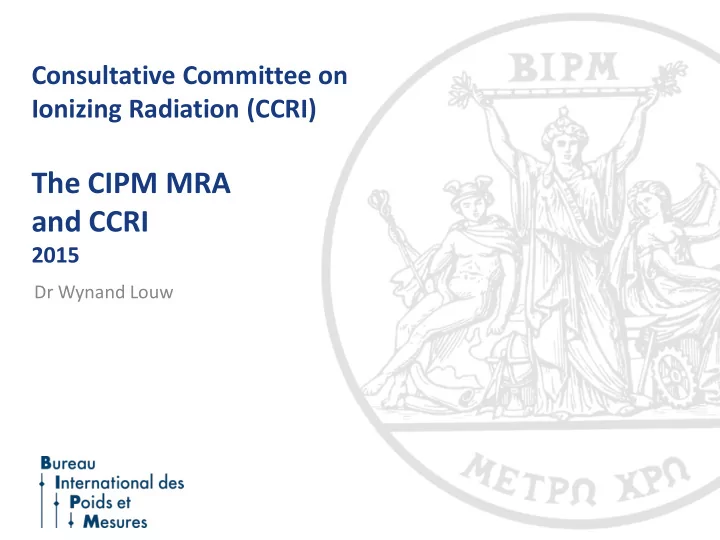

Consultative Committee on Ionizing Radiation (CCRI) The CIPM MRA and CCRI 2015 Dr Wynand Louw
Section(I) Section(II) x- and gamma rays, charged Measurement of radionuclides particles Dosimetry in air and water SIR Système International de Reference K air , D w : Gy (J.kg -1 ) Activity in Bq (1/s) H : Sv (J.kg -1 ) Section(III) Neutron measurements neutron fluence (m -2 ) 2
CCRI CIPM MRA Facts and Survey Some Facts Currently 4026 IR CMCs in the KCDB Euramet 1918 • comprising 17% of total APMP 821 Growing trend due to current and emerging • applications in health (radiodiagnostics, SIM 755 radiotherapy, nuclear medicine, etc.) in COOMET 471 nuclear energy, environmental monitoring, forensics and safety and security AFRIMETS 39 new NMI/DIs joining the field and producing • new CMCs to be reviewed and assessed IAEA 22 167 Comparisons of which CC RMO BIPM TOTAL Photons, ch. the BIPM pilots(ed) 67 particles 2 17 8 27 Radio nuclides (a) 28 18 69 115 Neutrons 25 0 0 25 67 167
CCRI CIPM MRA Facts and Survey CCRI Survey • Aim: to assess how the CCRI can best carry out its activities to meet the goals of the CIPM MRA in the most efficient and effective manner, by reviewing - the usefulness and accessibility of the KCDB, in particular of Appendix C, - the efficiency and effectiveness of the CMC review process, - the process of generating, formatting and presenting CMCs, including the scope of the claimed CMCs. • Distribution: all Section (I, II, III) members, observers, stakeholders, CCRI-RMOWG (RMO’s IR-TC Chairs)
Survey Results – Response Distribution CCRI Section Question CCRI Additional Institute 1 1 6 6 6 RMO I II III 2 3 4 5 7 8 9 10 11 12 comments WG .1 .2 .1 .2 .3 AFRIMETS-IR TC ARPANSA (Australia) BIM (Bulgaria) CMI (Czech Republic) CNEA (Argentina) EURAMET-IR TC GUM (Poland) IAEA (Intl. organization) KEBS (Kenya) LMRI-CIEMAT LNE-IRSN (France) LNE-LNHB (France) METAS (Switzerland) MIRS/IJS (Slovenia) MKEH (Hungary) NIM (China) NIS (Egypt) NIST (USA) NMIJ (Japan) NMISA (South Africa) NPL (UK) NRC (Canada) NRPA (Norway) PTB (Germany) RMOWG Coordinator SIM-IR TC VNIIM (Russia) Total received 15 1 14 1 7 1 4 1 34 34 34 33 33 31 15 15 32 33 31 34 25 26 24 3 35 1 33 1 16 1 9 1 % 100 100 100 97 97 91 44 44 94 97 91 100 74 76 71 9 1 including answers covering two or three sections: total effective number of responses 43.
Survey Results - Conclusions MAIN CONCLUSIONS A. Over 80 % of NMIs/DIs felt that the Appendix C of the KCDB is useful and should Continue. B. 100 % commented that the structured programme of comparisons organised under the CIPM MRA has been useful and should continue. Some optimisation suggested. C. Over 60 % prepare their CMCs for their customers, 44 % for Accreditation bodies, < 10 % for a mix of NMI/DIs, stakeholders and other customers. D. 70 % feels that the KCDB is easily readable and understandable as is, 30 % also agreed but recommended some improvements. E. 96 % felt that the CMCs correctly represented the capabilities. F. 90 % felt that it is properly representing their CRMs and should continue to do so. G. On the question “Should a strategy of accepting CMCs with wide scope be introduced” the responses were split: 50 % commenting YES, 9% MAYBE and 42% NO. The comments are being further analysed to better understand the replies.
Survey Results - Analysis and Conclusions cont. MAIN CONCLUSIONS Cont. H. 50 % agreed that peer-review reports and accreditation or third-party assessment reports would guarantee the reliability of claimed CMCs. The rest were proposing a diversity of other means that will be used to increase efficiency. On steps to improve the efficiency and effectiveness of the CMC review process; I. 65% felt that a reduction in the number of CMCs will improve the review process, 58% felt that On-site peer reviews by the CCRI could DECREASE the efficiency, 78% felt that more information available on the accreditation process and less RMOs reviewing each CMC should increase the efficiency and the effectiveness of the review process. J. 100% felt that no essential changes are needed to the CMC templates. Migration from pdf to searchable database has been suggested. K. The majority gave inputs on how the CCRI processes and documents could be improved to ensure that they appropriately support NMIs/DIs starting to develop measurement services in IR for the first time and wishing to have these recognised under the CIPM MRA.
Summary of Actions/Recommendations CCRI will continue to simplify the CMCs as already started with the Measurement Method Matrix (MMM) for radionuclide measurements Implementation in Dosimetry is being explored The revision of neutron CMCs could be done during the CCRI(III) meetings since this will allow the timeline for approval to be reduced The delays in completing comparisons for neutron measurements are being reduced by using a single central facility whenever possible, as in the case of the comparison on monoenergetic neutron fluence To extend its usefulness, the KCDB should be improved to offer a more user friendly interface for general users Section (II) is implementing simplified reports to reduce the time to publish radionuclide comparison reports The efficiency of the review process will be continuously improved with the suggestions from the NMI/DIs and the user community
Summary of Actions/Recommendations cont. Streamline CCRI organisation: Improve efficiency of meetings by; combining KCWGs organising RMO WG Chair on CMC meeting between CCRI(I) and CCRI(II) meetings shorten CCRI(III) meeting and conduct in parallel to (I) or (II) operate Sections like working groups but keep names send out one convocation for CCRI and three section meetings close BSWG(I) and ESWG(II) when appropriate www.bipm.org 9
Recommend
More recommend